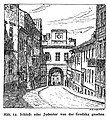Karl Richard executioner
Karl Richard Henker (born April 27, 1873 in Lauenstein , Saxony , † December 15, 1942 in Berlin-Charlottenburg ) was a German architect and draftsman who worked in Berlin .
Life
Henker was born in Lauenstein as the son of the inn owner Carl Wilhelm Henker and his wife Adolphine Marie Natalie, née Rouwolf. On October 25, 1902, he married the seamstress Clara Martha Selma née Sproßmann (* 1875) in Berlin-Charlottenburg. About himself he stated in a biography that he was “2 ½ years a soldier, 2 years a member of the art advisory board at the Austrian Gen. Govern. Lublin Poland ”.
In 1911 he became a member of the German Werkbund . At that time, executioner was a freelance architect and built country houses in the style of Hermann Muthesius , but also grave monuments in Berlin cemeteries. Before the First World War , from 1902 to 1913 he was in charge of documentation on modern tomb art. The Werkbund had dedicated its yearbook 1916/1917 to the topic of "War graves in the field and at home". In the area of occupied Poland, the military administrations cooperated German Empire and the Austrian imperial monarchy, presumably he was also involved here, officially, Karl Richard executioner does not find among employees.
After his military service in the First World War, he built up a second professional field in addition to his work as an architect, he became a drawing teacher for "linear drawing, perspective and architecture" at vocational schools and received the title of professor in 1923 , and in 1934 he was transferred to the "Aryanized" university of the arts Berlin . During the transition from vocational school to the University of the Arts, Henker had "embellished" his curriculum vitae and erased any reference to his work on Majer Balaban's book , "The Jewish City of Lublin".
His drawings of the buildings, street pictures and the Jewish cemetery in Lublin are in no way anti-Semitic, but show sober architectural drawings in a contemporary style. This is why his drawings can also be found in the 1927 Jewish Lexicon and in Lublin post-war publications.
Fonts
- The Jewish city of Lublin , Majer Balaban. With drawings by Karl Richard Henker. Jewish publishing house Berlin, 1919 [1]
- Funerary Art: A collection of masterpieces created in memory of the dead by contemporary artists ; Ed. Henker, Karl Richard, Verlag Baumgärtel Berlin [2]
literature
- Ed .: Balaban, Majer: The Jewish city of Lublin . With drawings by Karl Richard Henker. Ed .: Hartmut Eggert , Janusz Golec , reprint Lublin, Ośrodek "Brama Grodzka - Teatr NN" 2012, ISBN 978-83-61064-42-8
- Executioner, Karl Richard . In: Hans Vollmer (Hrsg.): General lexicon of fine artists from antiquity to the present . Founded by Ulrich Thieme and Felix Becker . tape 16 : Hansen – Heubach . EA Seemann, Leipzig 1923, p. 388 .
Web links
Individual evidence
- ↑ Wedding register Charlottenburg II, 1902 No. 772
- ↑ Ed .: Balaban, Majer: Die Judenstadt von Lublin . With drawings by Karl Richard Henker. Ed .: Hartmut Eggert , Janusz Golec , reprint Lublin, Ośrodek "Brama Grodzka - Teatr NN" 2012, ISBN 978-83-61064-42-8 , p. 117
| personal data | |
|---|---|
| SURNAME | Executioner, Karl Richard |
| BRIEF DESCRIPTION | German architect and draftsman |
| DATE OF BIRTH | April 27, 1873 |
| PLACE OF BIRTH | Lauenstein (Altenberg) |
| DATE OF DEATH | December 15, 1942 |
| Place of death | Berlin-Charlottenburg |






